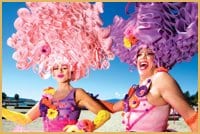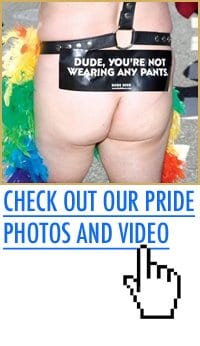
RECORD-BREAKING ATTENDANCE. Over 500,000 enthusiastic spectators lined the route from Robson and Thurlow to Sunset Beach Aug 3 for the Pride parade. This year marks 30 years of Pride in Vancouver. Credit: Sara Race photo
At the corner of Robson and Thurlow, as music pumps from multiple sound systems, Vancouver Pride parade participants put the finishing touches on their floats, pasting balloons and shiny streamers to vehicles and applying the last of body paint and makeup.
In the thick of it all, 78-year-old Clyde Rowett prepares to take the seat of honour in a convertible decorated with gold metallic streamers —the float for the Vancouver Prime Timers, a social group for senior gay men. He’s Marie Antoinette today, resplendent in a peach-coloured gown complete with a very ample bosom, white powdered makeup, bright lips and an 18th-century style wig.
This year’s parade attracted over 500,000 spectators, 165 floats and 3,459 participants to celebrate Pride’s 30th anniversary in Vancouver. But Rowett can remember a time when being gay wasn’t so open and accepted, both for society and especially for himself.
Rowett says he spent many years afraid to even watch the parade, and marvels at the fact that he now fully participates in it, in drag to boot.
“We’re so liberated now,” he says. “It’s a wonderful feeling.”
Since he began marching six years ago, Rowett says he’s seen the parade grow bigger and better, with a more enthusiastic crowd.
“The people are the best part,” he says. “The feeling of community —it’s a really fun day.”
Rowett’s partner of four years, Sid Jenner, 67, dressed as Nacho Libre in vibrant red and black, says that though life for gays and lesbians isn’t perfect today, things have certainly come a long way.
“It’s amazing to look back over the last 30 years and see how things have changed,” he says. “We know how lucky we are to be in Vancouver. It’s great to celebrate our freedom that we worked so hard for, but there are still parts of the world that are set back 50 years.”
No one knows that more than Sahran Abeysundara, one of three grand marshals in this year’s parade.
Abeysundara is still fighting for gay and lesbian rights in his home country of Sri Lanka. He organized Sri Lanka’s first Pride in 2005 —despite the fact that homosexuality is still a crime there punishable by 10 years in prison.
He has attended other Pride parades in European cities like Brussels and Brighton, but says he was absolutely blown away by what he saw at Pride in Vancouver.
“I thought to myself, ‘My god, look around at all these queer people being who they are and the police there not to arrest them but to protect them,'” he says. “The whole thing was so amazing and so special. I just loved every minute of it.”
That’s music to the ears of Pride Society president John Boychuk, who says he’s heard nothing but praise for the parade and the events leading up to it.
“It went off beautifully,” he says. “It just goes to show that people were really wanting to celebrate and have a good time, and [at Pride] they found it.”
With a 30 percent increase in spectators since last year and 100,000 people attending the post-parade festival at Sunset Beach, Boychuk says this year’s parade now holds the record for Vancouver’s largest one-day event.
It’s a far cry from 30 years ago, says Willi Zwozdesky, who remembers the early days of Pride well.
Zwozdesky, the conductor for the Vancouver Men’s Chorus (who, in their matching shirts and bow-ties, won the judges’ award for Best Crowd Response), has been marching in the parade for 27 years and has yet to tire of it.
“It’s always exciting,” Zwozdesky says, “and the crowd is fantastic.”
When the Pride parade first started, Zwozdesky says it was a small street party that catered only to the gay community, with fewer big floats and a focus on health issues. Now, apart from the sizeable growth of the parade, he sees more of a commercial focus and an increase in participation of youth organizations, as well as a wider range of participants.
“The diversity of participants is astonishing,” he says. “When
I go up the street, I never know what I’m going to see.”
The parade certainly showcased a great diversity of marchers, from small community groups to large corporations. Also in the parade was the usual contingency of politicians, over a dozen this year including big names like federal NDP leader Jack Layton, BC NDP leader Carole James, Vancouver mayor Sam Sullivan, mayoral candidates Peter Ladner and Gregor Robertson (on rollerblades), and Vancouver Centre
MP Hedy Fry, whose enormous float featured several underwear-clad men wearing signs on their butts proclaiming them to be Hedy’s Hotties.
Although Prime Minister Stephen Harper was in town Aug 3 to apologize to a Surrey crowd for the Canadian government’s decision to refuse entry to passengers of the Komagata Maru in 1914, he did not attend the Pride parade.
Among the many returning floats and participants in the parade were plenty of new people and entries too. Wayne Fritz, wearing a mini-dress made of multicoloured flowers, fuchsia press-on nails and five-inch stilettos, marched for the first time with Cirque de So Gay (which joined the parade lineup last year).
A popular photo target for the spectators, Fritz says he enjoyed the diversity, the colour and the fun of the 30th anniversary celebration.
“The best part is celebrating it with friends,” he says. “And it’s recognizing the struggle from the first Pride.”
Fellow marcher Hector Medina agrees. “It’s lovely, it’s incredible, the fact that we’ve come so far, and that’s illustrated by the number of people here today.”
Glenn Eden has been attending the Pride parade since he came out 22 years ago. He made an early trek downtown from Surrey with his partner (who lives in Port Coquitlam) so they could get a good spot.
“We had a lot of fun,” he says. “I had a great time, I loved it.
I always love going to the parade.”
In the years that Eden has been coming to the parade, he thinks it’s gotten better with age but also slightly worse, due to the increase in commercialism and the number of politicians jumping on the bandwagon with no connection to gay Pride. (Eden says he was asked by one marching politician if he had Eden’s vote).
“Why do we have someone handing out women’s razor blades at a Pride parade?” he asks. “That’s taking away from the meaning of gay Pride as far as I’m concerned.”
With a running time of more than three hours, many also thought the parade went on for a bit too long. Eden himself left after two and a half hours to go to the festival at Sunset Beach.
But the highlight for Eden was the newfound friends he made during the Parade. Sitting amongst a motley crew consisting of a couple of lesbians, a trans person, a straight couple, and a straight woman and her young gay son, Eden says he and his fellow Pridegoers became fast friends.
“The community was all coming together, and everyone was just having a blast,” he says. “It was as if we had all come in one group, and that’s what it’s all about.”
Pride 2008 video report:

 Why you can trust Xtra
Why you can trust Xtra


